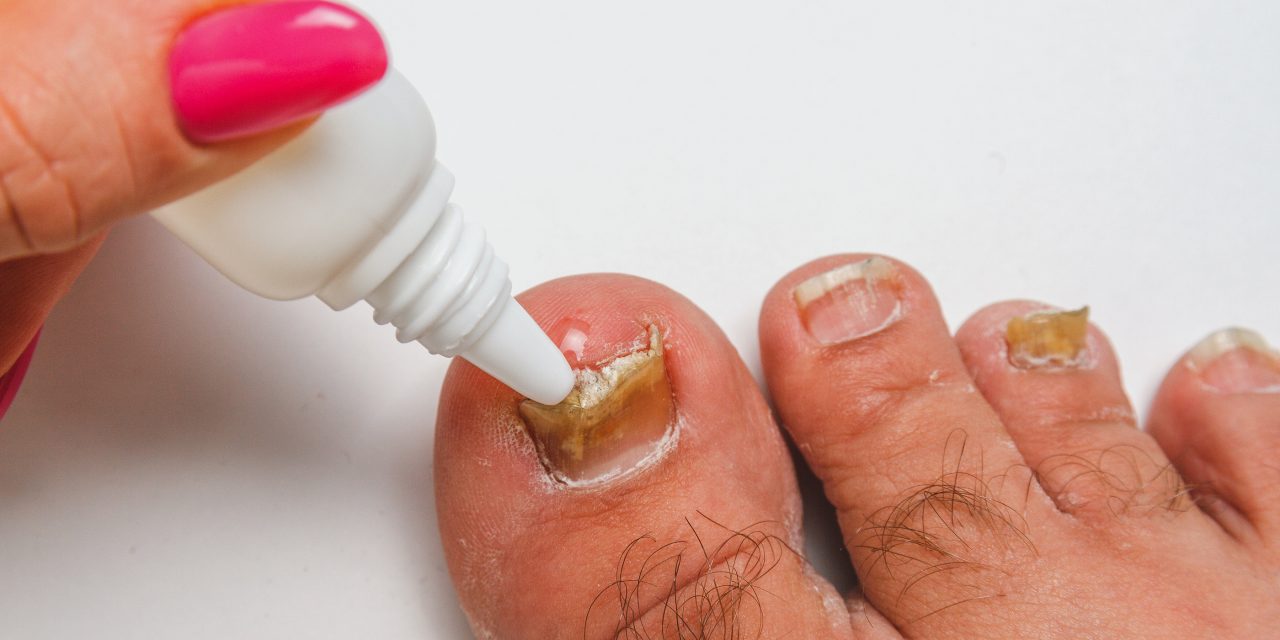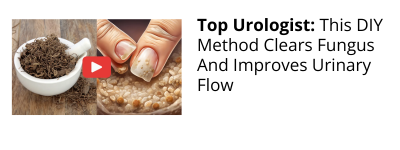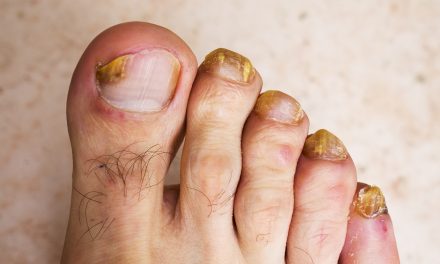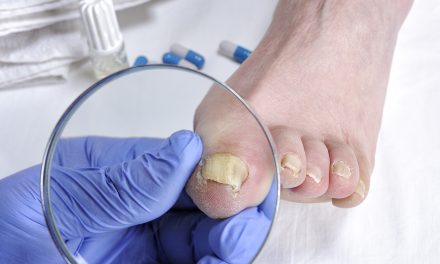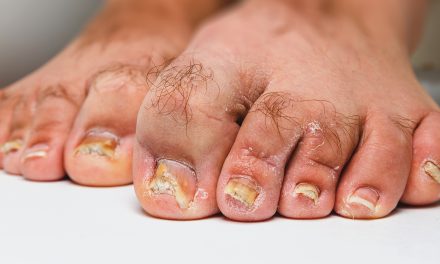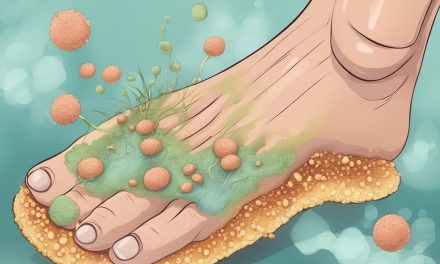Toenail fungus, or onychomycosis, is a common and persistent problem that affects millions of people around the world. Despite the prevalence of this condition, many are unaware of the treatment options available to them. This article seeks to provide valuable information on the various ways to combat toenail fungus instantly, providing relief and promoting healthy nail growth.

There are a myriad of factors that contribute to the development of toenail fungus, ranging from environmental influences to an individual’s overall health. Understanding the root cause of the infection is crucial in determining the most effective form of treatment, as well as preventing future recurrences. A diverse range of medical treatments, over-the-counter solutions, and natural remedies exist to target toenail fungus, all varying in cost, accessibility, and overall efficacy.
Key Takeaways
- Toenail fungus can be effectively treated with medical and natural options.
- Understanding the underlying cause is vital for choosing the right treatment and prevention.
- Consult a healthcare professional for persistent symptoms or potential complications.
Understanding Toenail Fungus
Toenail fungus, also known as onychomycosis, is a common fungal infection that affects the toenails. It is caused by a group of fungi called dermatophytes. These fungi thrive in warm, moist environments, making the feet an ideal breeding ground for infection.
There are several factors that contribute to the development of toenail fungus, including:
- Wearing shoes and socks that do not allow proper airflow
- Walking barefoot in damp public areas (e.g. swimming pools and locker rooms)
- Minor nail injury or skin conditions
- Weak immune system or chronic medical conditions (e.g. diabetes)
Identifying Toenail Fungus
Toenail fungus is characterized by various symptoms, such as:
- Discoloration: Nails may turn yellow, white, or brown.
- Thickening: Infected nails can become thick and difficult to trim.
- Distorted shape: As the infection progresses, nails may become warped.
- Brittle or crumbling: Fragile nails are a common sign of toenail fungus.
- Foul smell: Infected toenails can produce an unpleasant odor.
It is crucial to recognize these symptoms early in order to seek proper treatment and prevent the infection from spreading to other nails or causing complications.
Treatment Options
There are several options to effectively treat toenail fungus, ranging from over-the-counter (OTC) remedies to prescription medications. Some common treatments include:
- OTC Antifungal creams and ointments: These medications can be applied directly to the infected nail and surrounding area.
- Oral antifungal medications: These prescription drugs work from within the body to target the fungal infection.
- Medicated nail polish or creams: Prescription-strength products containing antifungal ingredients can help clear the infection.
- Laser therapy: In some cases, a healthcare professional may recommend using laser treatment to eradicate the fungal infection.
In order to achieve the best results, it is essential to combine proper hygiene and daily care with the selected treatment method. This may involve keeping the feet clean and dry, regularly changing socks, and wearing well-ventilated footwear.
Early detection and proactive treatment of toenail fungus is crucial in maintaining healthy nails and preventing long-term damage or complications.
Medical Treatments
Prescription Medications
There are several prescription medications available to treat toenail fungus. Some common choices include:
- Terbinafine (Lamisil): a popular oral antifungal medication that effectively kills various types of fungi
- Itraconazole (Sporanox): another oral antifungal medication often used for more severe cases or for patients who cannot tolerate terbinafine
- Efinaconazole (Jublia): a topical solution applied directly to the affected nails, usually recommended for milder cases of toenail fungus
It is essential to follow the prescribed treatment course and consult a healthcare professional if side effects occur.
Laser Therapy
Laser therapy offers an alternative to medications in treating toenail fungus. This method involves using safe and focused beams of light to heat and destroy the fungus beneath the nail, without damaging surrounding tissue. The main advantages of laser therapy are its non-invasive nature and lack of side effects. However, it may not be as effective as oral antifungal medications and can be more expensive.
Surgical Options
In extreme cases, healthcare professionals may recommend surgical options to eradicate toenail fungus. There are two main types of surgery:
- Nail avulsion: a procedure in which the entire affected nail is removed either using a local anesthetic or a more aggressive approach, which may require regional or general anesthesia.
- Nail debridement: the process of removing the infected portions of the nail, allowing the healthy nail to grow in its place.
Surgical options are typically reserved for severe or chronic cases where other treatments have failed. It is crucial to follow post-operative care instructions to avoid recurrence of the infection and ensure proper healing.
Over-the-Counter Solutions
Antifungal Creams
Antifungal creams are common over-the-counter (OTC) treatments that can help combat toenail fungus. They contain active ingredients like clotrimazole, terbinafine, and miconazole, which are effective in dealing with various fungal infections. To make the most of these creams, follow the steps below:
- Clean your feet and toenails thoroughly
- Dry them with a clean towel
- Gently apply the antifungal cream onto the infected toenail
- Allow it to dry
- Regularly apply the cream until the fungal infection is gone
However, it is essential to remember that effectiveness may vary depending on the severity of the infection. Consult with a healthcare professional if your symptoms persist or worsen.
Antifungal Nail Lacquers
An alternative OTC solution that specifically targets toenail fungus is antifungal nail lacquers. These medicated nail polishes, such as ciclopirox and amorolfine, gradually release antifungal agents into the nail bed, fighting off the infection. For optimal results, use the nail lacquer as follows:
- Trim the infected nail as short as possible
- Gently file the surface of the nail to increase lacquer absorption
- Clean the nail with alcohol
- Apply the nail lacquer according to the manufacturer’s instructions
- Allow the lacquer to dry
- Replace the lacquer as needed, typically once a week
Though they can help eliminate toenail fungus, patience is key as full recovery may take several months. Monitor your progress, and consult a healthcare professional for guidance on the persistent or worsening condition.
Natural Remedies
Tea Tree Oil
Tea tree oil, derived from the Melaleuca alternifolia plant, is a popular natural treatment for various skin conditions, including toenail fungus. Its antifungal and antiseptic properties make it effective in combating fungal infections. To use tea tree oil as a remedy:
- Clean and dry the affected toenail.
- Use a cotton swab to apply a few drops of tea tree oil on the nail.
- Let it absorb for about 10 minutes and then gently scrub the nail with a soft toothbrush.
- Repeat this process twice daily until the infection clears.
However, tea tree oil can cause skin irritation in some individuals. It is essential to perform a patch test prior to using it on your toenail.
Vinegar Soaks
Vinegar, particularly apple cider vinegar, is another widely used natural remedy for toenail fungus due to its antifungal properties. A vinegar soak can help balance the pH level of the affected area, making it inhospitable for the fungus to thrive. Follow these steps for a vinegar soak:
- Mix equal parts of water and vinegar in a foot basin.
- Soak the infected toenail for 20 to 30 minutes daily.
- Rinse and thoroughly dry your foot afterward.
It is worth noting that vinegar soaks may take several weeks or months to show significant improvement in the condition.
Garlic Extract
Garlic is highly regarded for its antimicrobial and antifungal properties, making it a potentially effective remedy for toenail fungus. The primary active compound in garlic, allicin, is responsible for its strong antifungal action. Here’s how to use garlic extract for toenail fungus treatment:
- Crush 2-3 cloves of fresh garlic to release the allicin.
- Apply the crushed garlic directly onto the affected nail.
- Wrap the toenail with a bandage to keep the garlic in place.
- Leave it on for 30 minutes before gently washing it off with lukewarm water.
- Pat dry the toenail and surrounding area.
Repeat this treatment once daily until you see improvement. Alternatively, garlic oil can be used instead of fresh garlic.
Remember that natural remedies may not work for everyone, and results can vary. Should your toenail fungus persist or worsen, it is advisable to consult with a healthcare professional for further evaluation and treatment.
Preventive Measures
Proper Foot Hygiene
Practicing proper foot hygiene is vital in preventing toenail fungus. Always wash your feet with soap and water daily and make sure to dry them thoroughly, especially between the toes. When trimming nails, cut straight across and avoid cutting too short, as this can create openings for fungus to enter. Additionally, remember to regularly disinfect personal grooming tools like nail clippers and files.
It’s also essential to:
- Wear clean socks each day, preferably made of moisture-wicking materials.
- Rotate your shoes to give them time to dry out fully between uses.
- Avoid walking barefoot in public areas, such as locker rooms or showers.
Moisture Control
Fungus thrives in damp environments, making moisture control a crucial preventive measure. To reduce moisture levels, consider the following tips:
- Choose breathable footwear: Opt for shoes made of materials such as leather, canvas or mesh that allow proper air circulation.
- Apply antifungal powder: Use an antifungal powder on your feet and inside your shoes to create a less favorable environment for fungi.
- Wear moisture-wicking socks: Look for socks made from materials like polyester, acrylic, or merino wool, which help keep feet dry throughout the day.
Both proper foot hygiene and moisture control are key factors in preventing toenail fungus. By being proactive in maintaining a clean and dry environment for your feet, you can significantly reduce the risk of developing an infection.
Environmental Factors
Moisture plays a significant role in the growth of toenail fungus. Fungi thrive in damp and humid environments, making wet shoes and socks, public swimming pools, and locker rooms prime breeding places. To reduce the risk of infection, it’s essential to keep your feet dry and choose breathable footwear.
Factors such as temperature and pH levels also influence fungal growth. Warm environments with a neutral to slightly acidic pH promote fungal infection. People living in hot and tropical climates should be extra cautious and maintain proper foot hygiene.
Some environmental factors that affect toenail fungus growth include:
- Humidity and dampness
- Temperature
- pH levels
- Exposure to contaminated surfaces
To protect your feet from fungal infections, consider implementing the following habits:
- Wear moisture-wicking socks to keep feet dry.
- Choose footwear made of breathable materials, such as mesh or canvas.
- Avoid walking barefoot in places with high humidity and possible contamination, such as public showers or locker rooms.
- Wash your feet daily with soap and water, and dry them thoroughly, especially between the toes.
- Use antifungal powders or sprays to combat potential fungal growth in shoes.
By controlling these environmental factors, you can create an unfavorable environment for toenail fungus and prevent its rapid growth. To improve foot health and reduce the risk of fungal infections, maintaining proper foot hygiene, and remaining vigilant about the environmental conditions your feet encounter is crucial.
Diet and Nutrition
A well-balanced diet and proper nutrition play a crucial role in preventing and treating toenail fungus. Incorporating specific foods and nutrients can help boost your immune system and create an environment that is unfavorable for fungal growth.
Antifungal Foods
Incorporating antifungal foods into your diet can help fight off toenail fungus. Some of the effective antifungal foods include:
- Garlic: A natural antifungal, garlic can be consumed raw, cooked or in supplement form.
- Onions: Known for their antifungal properties, onions can be consumed both raw and cooked.
- Coconut oil: Rich in medium-chain fatty acids, coconut oil has antifungal properties that can help combat toenail fungus.
- Yogurt: Unsweetened, probiotic yogurt contains beneficial bacteria that can help keep fungus in check.
Immune-Boosting Nutrients
A strong immune system is essential for preventing and treating toenail fungus. Focus on consuming foods rich in immune-boosting nutrients such as:
- Vitamin C: Found in citrus fruits, bell peppers, and leafy greens.
- Zinc: Present in red meat, poultry, beans, and whole grains.
- Selenium: Found in nuts, seeds, and fish.
- Vitamin E: Present in avocado, almonds, and sunflower seeds.
Foods to Avoid
Certain foods can indirectly contribute to toenail fungus by weakening your immune system or promoting an environment in which fungus can thrive. Some of these foods to avoid or limit include:
- Sugar: Fungus thrives on sugar, so reducing your sugar intake can help prevent fungal growth.
- Refined grains: Opt for whole grains instead of refined grains.
- Alcohol: High alcohol consumption can weaken the immune system.
Proper Hydration
While diet and nutrition have a significant impact on fungal infection prevention and treatment, it’s essential to maintain proper hydration. Consuming an adequate amount of water helps flush out toxins and supports healthy immune function. Aim for at least eight 8-ounce glasses of water per day.
By incorporating antifungal foods, immune-boosting nutrients, and proper hydration, you can create an environment where toenail fungus cannot thrive, significantly reducing the risk of infection and promoting faster recovery.
When to See a Doctor
Toenail fungus can be a stubborn and persistent condition. While there are many treatments available, it is essential to know when it is time to consult with a medical professional. Here is a list of crucial indicators:
- Severe pain or discomfort: If you are experiencing significant pain, redness, and swelling around the affected toenail.
- Non-responsive to over-the-counter treatments: If topical antifungal creams, gels, and nail lacquers recommended for at least six to eight weeks have not improved your condition.
- Spreading infection: If the fungal infection has spread to other nails or areas of your body.
- Predisposed health conditions: If you have diabetes or a weakened immune system, toenail fungus can lead to more severe complications.
Note: If you have concerns or doubts about your symptoms, it is always recommended to consult a doctor.
When visiting a healthcare professional for toenail fungus, here are some of the steps they may take to diagnose and treat the infection:
- Physical examination: Inspect the affected toenail to determine the severity and extent of the infection.
- Tests & diagnostics: They may perform a nail scraping or clipping for a lab test to identify the specific type of fungus causing the infection.
- Prescribed medications: Depending on the lab test results and the severity of the condition, your doctor may prescribe oral antifungal medications, topical treatments, or both.
- Nail removal: In cases where the infection is severe, unresponsive to medication, or significantly impacts patient’s quality of life, the doctor may suggest partial or total nail removal.
By knowing when to seek medical advice and what to expect during the consultation, you will be better equipped to deal with toenail fungus and work towards a swift recovery. Remember that early intervention is key to preventing complications and ensuring the best possible outcome.
Potential Complications
Toenail fungus, also referred to as onychomycosis, can lead to several complications if left untreated or improperly managed. In this section, we will discuss some of the potential issues that may arise.
Pain and Discomfort
An advanced toenail fungus infection can cause the nails to become thickened and brittle. This may result in significant pain and discomfort, especially when walking or wearing tight shoes. In some cases, the fungus can penetrate the skin, causing a secondary bacterial infection called cellulitis.
Spreading of Infection
Toenail fungus is contagious and can easily spread to other nails or even to your skin in the form of athlete’s foot (tinea pedis). It can also transmit through sharing personal items, such as towels, shoes, and nail clippers, or using public spaces like swimming pools and showers.
Weakening of the Immune System
Individuals with a weakened immune system due to conditions like diabetes, HIV/AIDS, or cancer may find it more difficult to fight off toenail fungus infections. This can lead to recurrent infections, increased likelihood of spreading to other parts of the body, and a higher risk of developing more severe complications such as deep tissue infections.
Loss of the Nail
In extreme cases, toenail fungus infections can cause permanent damage to the nails, such as the formation of abscesses under the nail, the nail separating from the nail bed, or even complete loss of the nail.
| Complication | Symptoms | Treatment |
|---|---|---|
| Pain and Discomfort | Thickened, brittle nails; pain when walking or wearing shoes | Oral antifungal medications, topical treatments, pain management |
| Spreading of Infection | Infected nails, athlete’s foot | Proper foot hygiene, avoid sharing personal items, use of antifungal creams or sprays |
| Weakening of the Immune System | Recurrent infections | Address underlying health conditions, consult a medical professional |
| Loss of the Nail | Nail abscesses, separation from nail bed, complete loss of nail | Surgical removal, professional care to restore the nail, preventative measures |
It’s crucial to address toenail fungus infections promptly and effectively to avoid these complications. While some over-the-counter treatments may be helpful, severe or recurrent infections may require professional assistance from a healthcare provider.
Long-Term Management
Preventing toenail fungus from recurring is an important part of long-term management. Here are some steps to follow after treating a toenail fungus infection:
- Maintain foot hygiene: Clean feet with soap and water daily, dry them well, especially between the toes.
- Shoes and socks: Wear breathable footwear and moisture-wicking socks to avoid creating a damp environment for fungi.
- Avoid walking barefoot: In public places like showers, pools, or locker rooms, wear flip-flops or sandals to reduce exposure to fungi.
- Protect the toenails: Keep nails short, straight, and avoid using the same tools for infected and healthy nails.
In addition to prevention, it is crucial to monitor any changes in your toenails. If signs of toenail fungus reappear, consult a healthcare professional for appropriate treatment. It is essential to address any recurring infections promptly to prevent complications.
| Antifungal Treatment | Regular Usage | Expected Results Time |
|---|---|---|
| Over-the-counter creams | Daily usage for a few weeks | 1-2 months |
| Prescription creams | Daily usage as recommended by healthcare professional | 2-3 months |
| Oral medications | Follow prescribed course | 3-6 months |
| Laser treatment | Sessions as recommended by healthcare professional | Varies depending on severity |
In conclusion, long-term management of toenail fungus requires continuous attention to foot hygiene and careful monitoring for any potential recurrences. Early detection, prompt treatment, and a commitment to prevention will help maintain healthy toenails and avoid complications.
Frequently Asked Questions
What are the top home remedies to eliminate toenail fungus quickly?
Some popular home remedies for treating toenail fungus include:
- Tea tree oil: Apply a few drops of tea tree oil on the affected toenail daily and let it soak in for about 20 minutes before rinsing off.
- Apple cider vinegar: Mix equal parts of apple cider vinegar and water, then soak your feet in this solution daily for at least 30 minutes.
- Baking soda: Create a paste of baking soda and water, apply it directly to the toenail, and rinse off after 15 minutes. Repeat this process once or twice daily.
- Garlic: Crush a few garlic cloves, apply the paste on the affected toenail, and leave on for 30 minutes before rinsing off.
Keep in mind that home remedies may not work for everyone, and it is essential to consult a healthcare professional if symptoms persist or worsen.
How effective is hydrogen peroxide in treating toenail fungus and what is the expected time frame for its action?
Hydrogen peroxide can help in treating toenail fungus by killing the fungi and bacteria that cause the infection. The expected time frame for its action varies, depending on the severity of the infection and individual responses. It may take several weeks to months before you notice significant improvement. In some cases, the damaged toenail may need to regrow completely before the infection is entirely eradicated.
What is considered the best medical treatment available for toenail fungus?
The best medical treatment for toenail fungus usually involves prescription antifungal medications, such as terbinafine and itraconazole. These medications are taken orally for several weeks to months, depending on the severity of the infection. Topical antifungal medications are also available but may be less effective in cases of severe infection. Always consult a healthcare professional for appropriate diagnosis and treatment options.
Is it possible to physically remove toenail fungus by scraping?
Physically removing toenail fungus by scraping may provide some temporary relief but may not eliminate the underlying infection. Scraping may damage the affected toenail, and the infection could worsen if not properly treated. It is essential to consult a healthcare professional for appropriate treatment, as they may recommend a combination of medications and physical removal methods, such as nail debridement or laser treatment.
Are there any natural solutions that effectively address foot and toenail fungus?
Natural solutions such as tea tree oil, apple cider vinegar, and garlic, as mentioned earlier, may help address foot and toenail fungus to some extent. However, the effectiveness of natural solutions may vary from person to person, and in some cases, medical treatments may be necessary. Consult a healthcare professional for proper diagnosis and treatment options tailored to your specific situation.
Which over-the-counter products are recommended for fast and effective toenail fungus treatment?
There are several over-the-counter (OTC) products available for toenail fungus treatment, including antifungal creams, ointments, and nail lacquers. Products containing clotrimazole, miconazole, or terbinafine are popular choices. However, OTC treatments may not provide a quick fix, and the effectiveness of these products may vary depending on the severity of the infection. It is vital to follow the instructions on the product label and consult a healthcare professional if symptoms persist or worsen.
Conclusion
In conclusion, while the desire for instant eradication of toenail fungus is understandable, it’s important to approach treatment with realistic expectations. Various remedies and solutions may offer benefits in managing toenail fungus, but achieving complete and immediate eradication is often a complex process that requires consistency and patience. Seeking guidance from healthcare professionals and exploring appropriate treatment options tailored to individual needs is essential for effectively managing toenail fungus. Additionally, practicing good foot hygiene, wearing breathable footwear, and adopting preventive measures are important for overall foot health and reducing the risk of toenail fungus. By being proactive and consistent in addressing toenail fungus, individuals can work towards improving the health and appearance of their nails over time.

